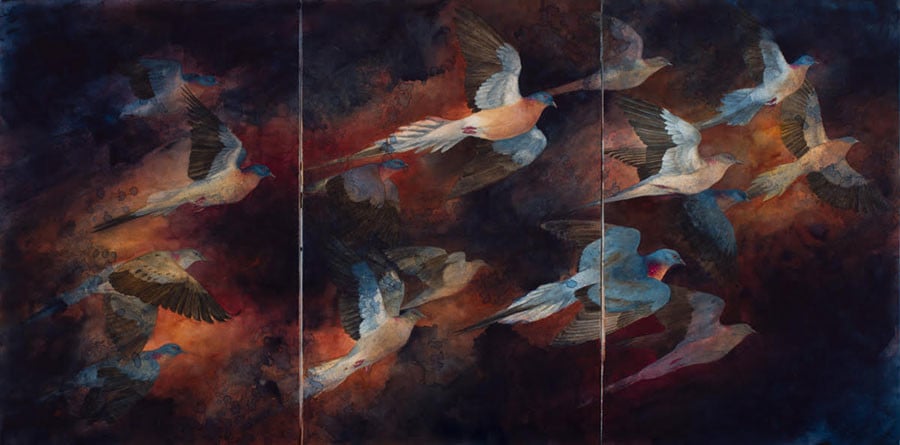Noyes exhibit promotes importance of bird conservation
“Tenebrous Flight” by Kristina Knowski is a part of “Birds in Jeopardy,” a new exhibit at the Noyes Cultural Arts Center. The exhibit opens on Nov. 1.
October 29, 2015
A&E
To artist Sarah Kaiser-Amaral, the preservation of birds involves more than just local habitats — their lives affect the stability of the entire ecosystem.
This connection is just one of many reasons Kaiser-Amaral chose to curate the “Birds in Jeopardy” exhibit at the Noyes Cultural Arts Center. The exhibit’s aim is to raise awareness about endangered and extinct birds.
The exhibit, which will run Nov. 1 through Dec. 1, includes about 15 art pieces, most of which are watercolor paintings, created by about seven artists. The artwork in the exhibit depicts scenes involving endangered or extinct birds, said Kaiser-Amaral, whose own work will be on display. To be featured in the exhibit, artists had to contribute a painting about an endangered or extinct bird and donate part of their art sales to an organization that focuses on bird conservation
Kristina Knowski’s watercolor paintings, featured in the exhibit, portray birds such as the extinct passenger pigeon, which was once the most common bird in the United States. The Chicago-based artist said the exhibit is a way to explore the relationship between humans and birds and show how human activity played a role in the animals’ extinction.
“(The passenger pigeon) was such a huge part of American history, and to have lost it and not know about it, I think it’s a real tragic loss,” Knowski said. “We already made our impact with the species by causing its extinction. I think the least we can do is understand what we are doing to other species at the moment.”
Maggie Weiss, an Evanston-based artist who uses cloth and quilts in her work, said her piece at the exhibit was inspired by actual events: In Arkansas in 2010, New Year’s Eve fireworks likely contributed to the death of up to 5000 red-winged blackbirds.
Kaiser-Amaral also said hazards against birds have increased in recent years. For instance, there are more high-rise buildings with reflective surfaces and birds, unaware of their own reflections, can slam into these exteriors.
She also said Evanston has seen a lot of property development in recent years that can increase habitat loss. She added that even Northwestern’s actions, like cutting down trees by the lakefront to build the new visitor’s center and parking garage, have had effects on the bird population in the area.
Kaiser-Amaral said she hopes the exhibit will make people realize they have a responsibility to help preserve the bird population, because without it, the entire ecosystem is thrown off-balance. Much like bees, birds are pollinators and help carry pollen from one source to another.
“It’s like a ripple effect. If (birds) are depleted, other species are also going to be affected,“ Kaiser-Amaral said. “They eat mosquitoes, so less birds would mean more mosquitoes, and mosquitoes carry viruses. It’s like the domino effect.”
Besides their role in the ecosystem, Weiss said birds should be valued for the vivacity they bring to everyday life.
“It would be much quieter and much less interesting to be in nature or just in your house,” she said. “You won’t hear bird songs (when you) wake you up or hear the birds in the evening to just round out your day.”
Email: [email protected]
Twitter: @_RachelYang


